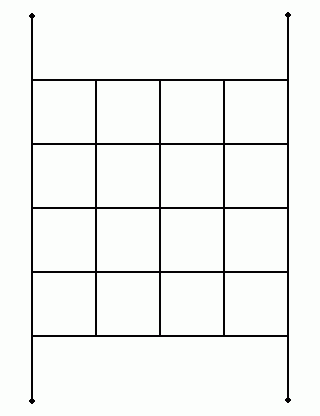Border Wars II
By Jared B. McComb
IntroductionBorder Wars II is played on the board shown at right. There are two players, Red and Blue. The game is played on the edges of the grid, not on the vertices or cells. There are 44 segments on the board, and therefore 44 spaces on which to move. The four vertical segments with the dots at the ends are called capital roads, and there are special rules which pertain to them. |

|

|
SetupHere is the initial setup. The Green pieces are neutral. Each player starts with:
|
Pieces
(These descriptions assume familiarity with movement, capture, and value terms defined in the original Border Wars.)Pawns may move one space crosspoint or crosscorner, and capture destructively. They are worth one point each. The neutral pieces are pawns, and follow the same rules as for Border Wars, with the exception that a neutral Pawn cannot capture another neutral Pawn.
Guards may move any distance crosspoint or one space crosscorner, and capture destructively. They are worth two points each.
Blockades may move any distance crosspoint or crosscorner. They do not capture and can only be captured passively. They are worth three points each and serve the very important purpose of annoying the opponent.
Chariots may move any distance crosscorner. They capture destructively and are worth two points each.
Diplomats may move one space crosspoint or any distance crosscorner. They capture passively and are worth three points each. If a player's diplomat reaches an opposing capital road, that player may take every piece worth three or fewer points from their opponent's hand and add them to their own.
Monks may move one space crosspoint or crosscorner. They capture passively and are worth four points each. Monks have a special power: when they are adjacent crosspoint or crosscorner to an enemy piece worth three or fewer points, they may cause it to change sides and remain on the board. This may be done to only one piece at once and counts as a turn. If a player moves a Monk to an opposing capital road, that player may take every piece from their opponent's hand and add them to their own.
Generals may move one space crosspoint or crosscorner. They capture passively and are worth five points each. Generals are always captured destructively, regardless of the capturing piece. If a player moves a General to an opposing capital road, that General successfully discusses peace with the other side and the game is drawn. The game is lost by the player who no longer has Generals on the board.
Pieces in reserve may only be entered on friendly capital roads. The fifty-move rule of Chess applies here, and three-time repetition is a loss for the player who makes the last move. Red has the first move of the game.
Vanquish
A player is vanquished and loses the game if all of the following conditions apply:- They have no pieces in hand.
- They have no Diplomats or Monks left.
- They have fewer than 5 non-General points left.
- All the neutral pieces have been captured.
Variants
Border Wars II Chess: Play with no reserve, no vanquish, no neutral pieces, and all captures destructive. Blockades can only be captured by Diplomats or Generals. When a player has one General left, they are bound by the rules of check and mate. (Since there is no reserve, there will be no Monks in play.)Border Wars II Shogi: Play with initially empty reserve, no vanquish, no neutral pieces, and all captures passive. Blockades can only be captured by Diplomats or Generals. As in Border Wars II Chess, when a player is reduced to a single General they must follow the rules of check and mate. (No Monks again.)
Border Wars II Xiang-Qi: Play as Border Wars II Chess, but with Blockades replaced with Cannons. Cannons have the same move as Blockades, but may capture as Xiang-Qi Cannons, and there is no restriction as to what can capture them.
Border Wars II Changgi: Play as Border Wars II Xiang-Qi, but the Cannons must follow all movement and capture restrictions present in Changgi. Also, each player may rearrange their Diplomats and Chariots to their liking before the game starts.
Credits
This game was based on Border Wars, but you already knew that.The Chariots arose out of a desire to create a long-range piece that was not nearly as powerful as a Diplomat, and the Monks arose out of a desire for something extremely powerful but short-ranged.
This game was not designed to be an "improvement" or an "extension" of the original Border Wars - Border Wars was a good game that does not need improving upon. However, I had been wanting to create another segment-based variant for awhile, and the number of spaces in this contest presented itself as a nice board shape. I suppose you could say that I wanted to fit Border Wars on this board shape, and I needed new pieces because it was supposed to be a fresh game.
Written by Jared B. McComb.
WWW page created:April 22th 2004.
